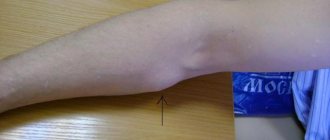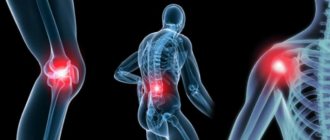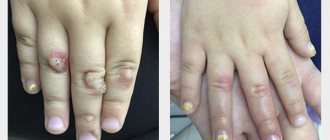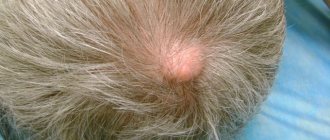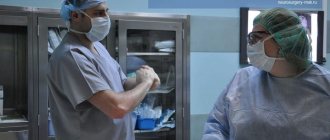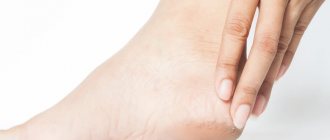Home > Laser surgery / Removal of tumors / Removal of lipomas > Laser removal of wen on the head
A benign formation that forms from subcutaneous adipose tissue is called a wen. If it causes physical or aesthetic discomfort, it should be removed.
A fatty tissue (also called a lipoma) is formed from subcutaneous fatty tissue. Can be located on the head, face, body, arms and legs. This is a soft, mobile formation, there is no painful sensation when you press it, its contours are clearly marked. Wen is a benign formation, but if it causes inconvenience, it is removed.
Consultation on the day of the procedure is free
Why do wen appear?
Poor nutrition and a sedentary lifestyle lead to metabolic disorders, and this causes the appearance of wen. When malfunctions constantly occur in the body, this disrupts the functioning of the sebaceous glands, adipose tissue begins to accumulate around one of them, and a lipoma forms.
In order for a doctor to confirm the presence of a wen, you need to go to a medical clinic and undergo a special examination. Usually a visual examination is enough for the doctor to make a diagnosis. If the formation is large, he may additionally prescribe an ultrasound, biopsy and x-ray examination.
Based on visual examination and testing, your healthcare professional will recommend monitoring the growth or removing it.
Why should you delete
The wen must be removed if it causes pain or physical discomfort. It is necessary to get rid of a lipoma if there is rapid growth, fluid is released from the site of formation, and the color of the skin around it changes.
The doctor will advise removing the wen if it:
- located on the neck, eyelids, eyes;
- causes aesthetic discomfort (for example, located on the face or head and has reached a significant size);
- this formation puts pressure on the internal organs;
- formations located in places that are injured by clothing (for example, armpits) or in another way (for example, fat located on the head and injured by a comb) must also be removed.
Benign or malignant?
Modern diagnostic capabilities make it possible to obtain verified results of examining fibroids on the head without spending a lot of time. The main reason for conducting research manipulations is to confirm the good quality of education. For this purpose, the following types of research are prescribed:
- Basic examination and clinical picture;
- Ultrasound, determination of accumulations of adipose tissue;
- CT scan;
- Electroradiography of soft tissues;
- Needle biopsy.
Quick acquisition of information and its competent analysis make it possible to recognize the degeneration of tissue in the very embryo. Using laboratory data, the surgeon selects the optimal method of performing the operation and prescribes the appropriate tests.
Useful information about visiting a surgeon at the clinic:
- How to prepare for a surgeon's appointment
- What diseases does the surgeon treat?
- Calling a surgeon to your home
- Surgical care in the clinic
- Surgical care at home
- What symptoms should you contact a surgeon for?
- Treatment of surgical diseases
- Treatment of intestinal pathologies
- Treatment of skin surgical pathologies
- Treatment of bedsores and necrosis
- Treatment of parasitic diseases
- Treatment of inflammatory processes of soft tissues
- Treatment of diseases of the musculoskeletal system
- Diagnosis of surgical diseases
Cost of removing lipomas (fat) with laser
| Laser tumor removal | Prices, rub. |
| Laser removal of papillomas, single warts - Cat. I. difficulties | 1200 |
| Laser removal of papillomas, multiple warts - Cat. I. difficulties | 350 |
| Laser removal of moles, papillomas, warts - Cat. II. difficulties | 700 |
| Laser removal of moles, papillomas, warts - Cat. III. difficulties | 1500 |
| Laser removal of moles, papillomas, warts - IV category. difficulties | 3000 |
| Laser removal of moles, papillomas, warts - Cat. V. difficulties | 4500 |
| Laser removal of moles, papillomas, warts - Cat. VI. difficulties | 6100 |
| CO2 Laser callus removal (per unit) | 6100 |
| Removal of atheroma, lipoma, fibroma, xanthelasma with laser - Cat. I. difficulties | 6 900 |
| Removal of atheroma, basal cell carcinoma, lipoma, fibroma, xanthelasma with laser - Category II. difficulties | 9 400 |
| Removal of atheroma, basal cell carcinoma, lipoma, fibroma, xanthelasma with laser - Cat. III. difficulties | 16 900 |
| Removal of atheroma, basal cell carcinoma, lipoma, fibroma, xanthelasma with laser - IV category. difficulties | 22 400 |
| Removal of atheroma, basal cell carcinoma, lipoma, fibroma, xanthelasma with laser - Cat. V. difficulties | 33 400 |
Make an appointment for laser removal of a wen on the head
- Full name
- Telephone
How and with what to treat
If the wen is small in size, the doctor may order observation of it or choose conservative treatment methods.
Usually this is the subcutaneous administration of special drugs that can cause the resorption of the wen. In situations where the formation needs to be removed, the doctor decides on surgical treatment. Main removal methods: surgical, radio wave, laser.
The most commonly used is laser. The procedure is painless and gives excellent results. After it, there are no scars left, and the formation no longer causes discomfort. The use of a laser allows for treatment with minimal damage.
The beam precisely affects the site of the tumor, and healthy cells are not affected. The tumor can be removed along with the capsule and sent for examination.
The laser solves two problems at once: it removes tissue with pathology and coagulates the surgical field, which guarantees speedy healing and the absence of side effects.
This method guarantees rapid healing and almost completely eliminates the risk of relapse.
After the operation, all tumors are sent for histological examination. This is necessary to exclude the presence of malignant cells in the formation.
Wen on the head is removed mainly with a laser.
How is the operation performed?
Wen removal is performed by an oncologist or plastic surgeon. For small sizes, local anesthesia is used.
The operation takes from 15 to 40 minutes, it all depends on the size and location of the lipoma. Usually the patient can return to their normal routine on the same day. In particularly difficult cases, the doctor may recommend 1-2 days of bed rest.
Photos before and after lipoma removal
The best treatment methods
Conservative treatment is considered futile. Folk remedies, through aggressive influence, can cause suppuration or malignancy. Surgery is considered the main and reliable way to get rid of the defect. There are several removal technologies:
- Liposuction. The procedure is performed under local anesthesia. Characterized by the absence of scars. The fat is sucked out with a special needle. Rehabilitation is fast.
- Surgical excision. It is used for infection, pain, pus formation. In difficult cases, general anesthesia is used. The best option to completely eliminate the problem.
- Laser removal. When the laser affects the affected area, nearby tissues are not affected. The operation is performed in an outpatient setting.
- Radio wave therapy. A virtual scalpel, based on radio waves, destroys tumor tissue. Complete restoration without surface defects.
The prognosis is favorable. The lipoma on the back of the head is completely removed and there are no relapses. Experienced certified specialists of the clinic, doctors of the highest category, thoroughly control the process from the first appointment until the end of the rehabilitation period and full recovery. The patient is informed of the observance of rules to prevent pathogenic microorganisms from entering the wound.
Diagnostic methods in surgery:
- Doppler in surgery
- Colonoscopy
- Angiography
- CT scan
- Gastroscopy
- MRI
- Abdominal ultrasound
- X-ray
- Endoscopy
Prices:
| Code | Name of service | Prices |
| 1 | Initial appointment | 1200 |
| 2 | Repeated appointment | 900 |
| 3 | Calling a surgeon to your home | 3500 |
| 4 | Abdominal ultrasound | 2200 |
| 5 | Ultrasound of veins and vessels | 2400 |
| 6 | Doppler 2-3 trimester | 1200 |
| 7 | Rectoscopy | 1500 |
Our specialists
- Kiani Ali
Candidate of Medical Sciences, laser medicine specialist, dermatocosmetologist.
Sign up
- Stepanova Inna Igorevna
Candidate of Medical Sciences, maxillofacial surgeon, specialist in laser medicine.
Sign up
- Fedotova Marina Andreevna
Surgeon, dermatocosmetologist, laser medicine specialist
Sign up
- Popovkin Pavel Sergeevich
Surgeon, oncologist, laser medicine specialist.
Sign up
Precancerous neoplasms (precancrosis)
Precancerous neoplasms are those that, under the influence of congenital or current causes, have acquired a tendency to malignant degeneration. As a rule, these are chronic conditions that are observed in a person for a long time.
Thus, precancerous tumors are dangerous neoplasms on the skin that can lead to the development of oncological processes. These include:
- Actinic keratoma is a keratosis in which dry crusts and scales appear on the skin of older people. When they peel off, slight bleeding may occur.
- Xeroderma pigmentosum is a hereditary tumor that develops due to increased sensitivity of the skin to ultraviolet radiation. Rarely encountered, these are pigmented spots that become warty growths.
- The cutaneous horn is a cone-shaped tumor that looks like a horn. Has a yellow or brown color. occurs in exposed areas of the body that are regularly subjected to friction or pressure. Typical for older people
- Bowen's disease is an intraepidermal cancer. Without treatment, it can transform into invasive skin cancer. In the early stage, Bowen's disease appears as a small reddish-brown spot measuring 2-50 mm. has a flaky surface and raised, uneven edges. After removing the scales, a weeping but not bleeding surface remains.
General information
The term lipoma comes from the Latin word for fat.
This is a benign connective tissue tumor. It develops in a layer of loose connective tissue under the skin and can penetrate deep, developing between the muscles and bundles of blood vessels to the periosteum. The ICD-10 code for lipoma is D17. 9 (benign neoplasm of adipose tissue of unspecified location). Speaking about lipoma - what kind of disease it is, it should be noted that among the people, the disease, which is scientifically called lipoma, is often defined as a wen. This tumor grows slowly, has a soft consistency, is mobile and painless. Most often, this formation develops in places where there is little adipose tissue: on the shoulders, upper back, outside the thigh. In most cases, such a tumor does not pose a danger from the point of view of degeneration into malignant. But in rare cases, lipomas in the subcutaneous fat still degenerate into liposarcoma (malignant formations).
Lipoma develops from adipose tissue and is one of the most common soft tissue tumors. Often such formations are multiple, sometimes they appear symmetrically. There are many varieties of such tumors that have certain morphological and clinical features. Such tumors develop equally often in men and women. The average age of appearance of lipomas is 40-60 years.
This article will discuss what a lipoma looks like, why it appears, as well as how to distinguish a wen from a tumor and get rid of such a formation.
What does a lipoma look like?
Fatty soft subcutaneous formations are not fixed in one place and move slightly if you press on them. The skin over the lipoma does not change. It looks healthy - does not darken, does not redden and maintains normal elasticity.
How big does a lipoma look?
New growths grow very slowly. Within a few years they reach 2-3 cm, and only in the rarest cases do they grow up to 10 cm. Such lipomas are called giant.
The larger the lipoma, the more dangerous it is. Not by itself, but because it puts pressure on neighboring tissues and can disrupt blood circulation. In addition, large tumors are a serious cosmetic problem, especially when they form on exposed parts of the body.
Sometimes not one lipoma grows, but several. But most patients have no more than one or two. Dozens of lipomas are rare. Mostly men face this problem. Doctors call the phenomenon multiple familial lipomatosis.
From the description of lipomas, let's move on to the reasons for their occurrence.
List of sources
- Artamonov R.G., Glazunova L.V., Bektashyants E.G., Kuibysheva E.V., Narinskaya N.N. Abdominal lipoma - difficulties of differential diagnosis // Medical scientific and educational journal. - No. 31. -2006.
- Congenital lipomas of the brain and spinal cord: clinical and MRI diagnostics / Bein B.M., Syrchin E.F., Yakushev K.B. // Medical almanac - 2013 - No. 3.
- Dergachev, S.V. Surgical treatment of lipomas in the practice of an outpatient surgeon / S.V. Dergachev [and others] // Outpatient surgery. Hospital-replacing technologies. – St. Petersburg, 2001. – No. 1 (1). – pp. 33–35.
- Encyclopedia of Clinical Oncology: a guide for practicing physicians / edited by. ed. M.I. Davydova, G.L. Vyshkovsky. M.: RLS, 2005. pp. 365-366.
Treatment with folk remedies
It is possible to treat wen using folk remedies only if they are practiced as an additional method. Basically, various compresses are used for this purpose.
- Kalanchoe and aloe . A fresh leaf of the selected plant is cut lengthwise and the pulp is applied to the affected area. It can be fixed with a plaster or bandage and worn for several hours. Repeat the procedure daily.
- Onions with soap . A large onion is baked in the oven, then pureed until it becomes a paste. It is mixed with grated laundry soap. The mass is applied to the lesion and fixed. The compress is replaced with a fresh one three times a day. It is recommended to use it for several days, then take a break.
- Honey compress . To prepare it, mix equal parts of salt, honey and sour cream. Apply the mixed mass to the wen and secure the bandage. This compress is carried out every day.
- Vegetable oil compress . Mix equal parts sunflower oil and vodka, soak a cloth in the resulting mass and apply it to the lipoma. Cover the fabric with paper for compresses. Carry out the procedure every day, leaving the compress on for several hours.
- Garlic and lard . Take two parts of fresh lard and one part of garlic, grind everything in a meat grinder, after which the mass is kept on low heat for about 15 minutes. A thin layer of the mass is applied to the formation, covered with a leaf of fresh cabbage and wrapped in a warm cloth. Treatment is carried out every day.
- Red pepper . For such a compress, the fabric is soaked in vodka and 1 tsp is poured onto it. red pepper. Apply it to the formation and hold for about 10 minutes. This compress helps improve blood circulation. However, it can cause burns and allergic reactions.
Pathogenesis
Currently, there is no consensus on the pathogenesis of lipoma. In some sources, this tumor is considered hypertrophied adipose tissue, in others – a true neoplasm. When tumors occur in areas where adipose tissue is absent, their development is associated with metaplastic transformation of connective tissue cells.
There is a theory that local accumulation of adipocytes occurs due to chromosomal abnormalities affecting the genes that are responsible for the synthesis of TAG lipase. This enzyme regulates the breakdown of fats and energy supply to the body.
There is also a theory that subcutaneous wen appears due to excessive deposition of lipids in adipose tissue cells. Certain prerequisites for the occurrence of such formations appear already during the period of embryonic development, when adipose tissue is just being formed. Subsequently, in adulthood, a wen may form on the arm under the skin or a tumor in other places.
Diet
Diet for skin diseases
- Efficacy: therapeutic effect after a month
- Time frame: three months or more
- Cost of products: 1400-1500 rubles per week
Despite the fact that nutrition does not directly affect the development of wen, it is important for people prone to their formation to adhere to some important rules:
- Do not overeat fatty foods.
- Reduce the amount of salt and sugar in your diet.
- Reduce the amount of baked goods and flour products consumed.
- Drink enough fluids.
